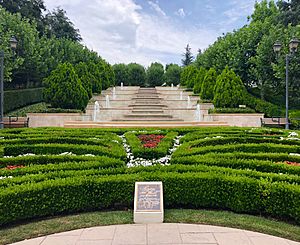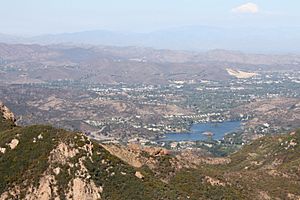Conejo Valley facts for kids
The Conejo Valley is a beautiful area in Southern California, United States. It stretches across parts of Ventura County and Los Angeles County. This valley is in the bigger Los Angeles area.
Many towns and cities are in the Conejo Valley. These include Thousand Oaks, Newbury Park, Westlake Village, Oak Park, Agoura Hills, and Lake Sherwood. A small part of Calabasas is also here.
Contents
What Does "Conejo" Mean?
Have you ever wondered where the name Conejo Valley comes from? In 1803, the Spanish gave a land grant in this area the name Rancho El Conejo.
In Spanish, the word conejo means "rabbit". This name was chosen because many rabbits lived in the valley. You can still see desert cottontail and brush rabbit species there today!
A Look Back: Conejo Valley History
Let's explore the interesting past of the Conejo Valley. People have lived here for thousands of years.
Ancient Times: The Chumash People

The very first people to live in the Conejo Valley were the native Chumash people. They built several important villages. Some of these villages were Satwiwa ("The Bluffs") in Newbury Park and Sap'wi ("House of Deer") in Thousand Oaks. Another village called Hipuk was in Westlake Village.
Sap'wi is located near the Chumash Indian Museum in Oakbrook Regional Park. This park is also home to ancient pictographs. These are rock paintings that are 4,000 to 6,000 years old. You can see them on special guided tours. Satwiwa was first settled about 13,000 years ago. It was at the base of Mount Boney, which was a very important mountain to the Chumash. Today, you can visit the Satwiwa Native American Indian Culture Center.
Other Chumash villages were found near Ventu Park Road. These villages had 100 to 200 people each. They were settled around 2,000 years ago. A smaller village, Yitimasɨh, was where Wildwood Elementary School is now. When people explored nearby Wildwood Regional Park, they found old shell beads, arrowheads, and stone tools.
First European Visitors
The Chumash villagers first met Europeans in 1770. A Spanish group led by Gaspar de Portolá came into the valley. They were returning from a long trip up the coast to San Francisco. On their way back, they looked for a shorter path to the San Fernando Valley. Native people helped guide them over the Conejo Grade.
A missionary named Juan Crespi wrote about the trip in his diary. He gave the Conejo Valley a name that is still used today: Triunfo. This Spanish word means "triumph." Crespi named a camping spot by a creek El triunfo del Dulcísimo Nombre de Jesús. Today, Triunfo Canyon Road starts near this area.
Later, explorer Juan Bautista de Anza used Portolá's shortcut in 1774. He also wrote about stopping at "El Triunfo." On his second trip, another diarist, Father Pedro Font, mentioned "many watering places, like those of El Triunfo and Los Conejos."
Ranching Days
In 1910, Harold and Edwin Janss bought a huge piece of land. It was about 10,000 acres (40 square kilometers) and is now central Thousand Oaks. This land was part of the original Rancho El Conejo grant.
The Janss family created a ranch called the Janss Conejo Ranch. They used it for farming and raising fast thoroughbred horses. The beautiful Santa Susanna Mountains and Simi Hills surrounded the ranch. This ranch became a popular place for filming movies and TV shows. Famous Westerns like The Rifleman, Gunsmoke, and Bonanza were filmed here in the 1950s and 1960s. Disney movies like Davy Crockett, King of the Wild Frontier and Westward Ho, the Wagons!, both starring Fess Parker, were also filmed at Janss Conejo.
Where is Conejo Valley?
The Conejo Valley is a valley about 900 feet (274 meters) high. It is surrounded by different natural features. To the east, you'll find the San Fernando Valley and the city of Los Angeles. The Simi Hills are to the north. To the northwest are the Las Posas Hills and the Santa Rosa Valley. The Conejo Mountain (also called Conejo Hills) and the Oxnard Plain are to the west. Finally, the Santa Monica Mountains are to the south. The valley itself is located on a raised area within the Santa Monica Mountains.

Working in Conejo Valley
Many different companies and organizations provide jobs in the Conejo Valley. Some of the largest employers that are not retail stores include Amgen, a big biotechnology company. The Conejo Valley Unified School District also employs many people. Other major employers are Los Robles Regional Medical Center, Anthem Blue Cross, and California Lutheran University. You can also find Shire Biotechnology, Skyworks Solutions, PennyMac Mortgage, and Sage Publications here.
Other well-known companies in the area include Jafra Cosmetics, Teledyne, J.D. Power, Dole Food Company, Guitar Center, Bank of America, and Teradyne.
News and Radio
The Ventura County Star is a daily newspaper that covers all of Ventura County, including the Conejo Valley.
There are also local weekly newspapers. The Acorn covers Agoura Hills, Hidden Hills, Oak Park, North Ranch, and Calabasas. The Thousand Oaks Acorn covers Thousand Oaks, Newbury Park, and Westlake Village.
KCLU is the only public radio station in Ventura County.
Fun Things to Do in Conejo Valley


In 2013, the Conejo Valley Tourism Improvement District (CVTID) was created. This group helps promote the Conejo Valley as a great place to visit. Two of the biggest attractions near the Conejo Valley are the Ronald Reagan Presidential Library in Simi Valley and the Santa Monica Mountains National Recreation Area.
Places to Explore
There are many interesting places to visit in the Conejo Valley:
- American Radio Archives and Museum: This museum has one of the world's largest collections about radio broadcasting.
- Conejo Valley Art Museum: An art museum located at Janss Marketplace in Thousand Oaks.
- Conejo Valley Botanic Garden: A large 33-acre botanical garden. It is right across from Tarantula Hill.
- Gardens of the World: Another beautiful botanical garden. It is across Thousand Oaks Boulevard from the Thousand Oaks Civic Arts Center.
- Grant R. Brimhall Library: One of the biggest libraries in Southern California.
- Joel McCrea Ranch: A 19th-century ranch at the bottom of the Norwegian Grade. It is listed on the U.S. National Register of Historic Places.
- Paramount Ranch: A famous movie ranch in the Santa Monica Mountains of Agoura Hills.
- Pederson House and Water Tower: A historic home built by the Norwegian Colony. It is on the campus of California Lutheran University.
- Stagecoach Inn: A museum and 19th-century hotel in Newbury Park. It is also listed on the U.S. National Register of Historic Places.
- The Oaks: The largest shopping mall in Ventura County.
- Wildwood Regional Park: A large 1,765-acre regional park. It borders another 1,400 acres of open space reserve.



